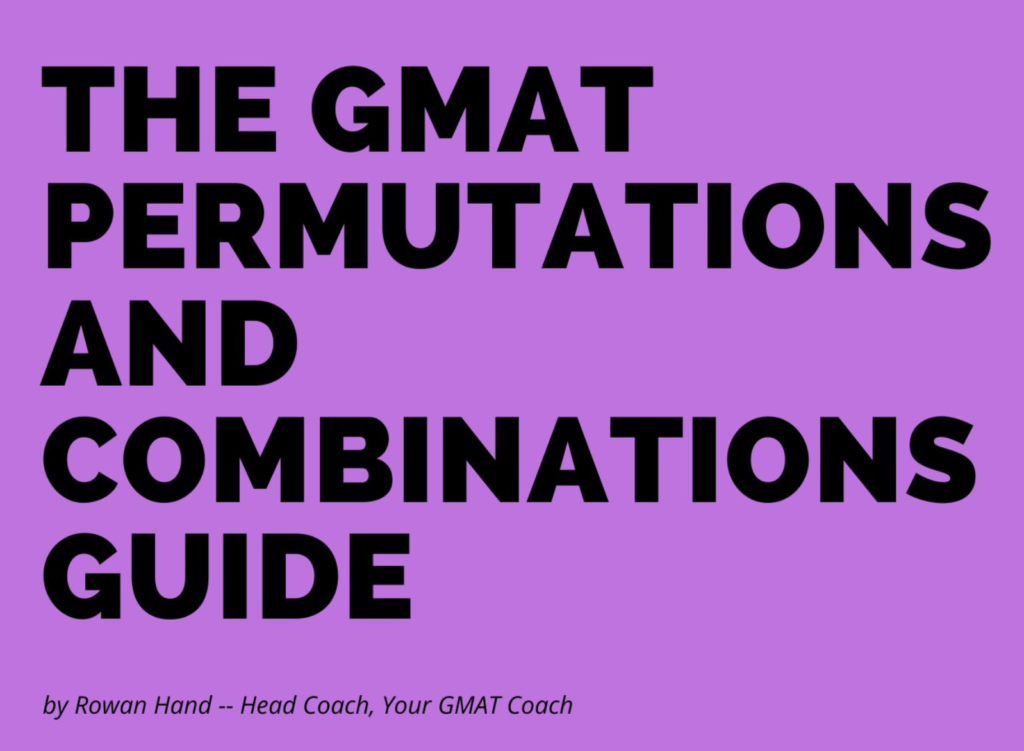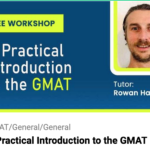GMAT Critical Reasoning Necessary vs. Sufficient — Can the Distinction Help You?
Let’s start with a quick definition of what an “Assumption” is. If you’re from Midwestern America, like me, I’m sure you know that “to assume makes an ass out of U and ME.”
You could say that on some level the GMAT feels the same way. Assumptions suck, unless they’re sanctioned by the testwriters.
This is the difference between Trivial and Non-Trivial Assumptions
What’s a Trivial Assumption?
After all, it is technically an Assumption that we both speak English–that you know how to read it and that I know how to write it. Now perhaps this article is just the chance product of 20,000 monkeys at 20,000 typewriters tapping away for 20,000 years.
There’s no sense behind it; it is merely a product of chance. Perhaps you’re scanning the words and making stuff up as you go along that you just assume–yes–corresponds to the words on the screen. Don’t scoff at me–one does not know what one does not know.
These assumptions would be a bit outlandish, and probably not something that would come up on the GMAT.
That is, the GMAT would think it’s obvious that a person taking the GMAT speaks English well enough to, well, take test. Hence, Trivial.
The GMAT would think that it’s obvious that a person who wrote for the test–which is given in English–would speak English and not actually be a football stadium full of monkey typists. Likewise, Trivial.
Let’s examine the Necessary vs. Sufficient distinction and how this relates. In short, these wacky, hyper-skeptical Trivial Assumptions are “reasonable by GMAT standards” and therefore trivial: they can be ignored. It’s not helpful to be paranoid about absolutely everything–let me tell you from experience.
Rather, what GMAT Critical Reasoning dislikes is Non-Trivial Assumptions.
That is, a Non-Trivial Assumption would overtly make an argument incomplete.
Put another way, some of the link between the Facts and Conclusion of the argument go unstated. This creates a logical gap in the argument.
If you think of the facts as wood pieces and the argument as the chair created when the wood is pieced together a certain way, the Assumption would be the crappy glue used to hold the wood together.
A master woodworker, however, can cut joints in wood so well that the glue isn’t even totally necessary–it’s just used as a strengthener. Likewise, given the social, theoretical, and academic structures of the modern Western world, certain arguments will essentially fit together without requiring any Non-Trivial Assumption.
However, if the wood isn’t jointed precisely and the only thing keeping your ass from hitting the ground–hard–is a gigantic smear of that glue that you bought out of the sales bin at Harbor Freight, you might just realize what a liability glue is–and, if it’s not clear, by glue I mean a Non-Trivial Assumption.
You would be correct to recognize that you’re never going to turn an argument that involves Assumptions at all into a perfect deductive argument. You’re just trying to minimize the Assumptions to eliminate any other non-trivial or “reasonable” possibilities.
Let’s now look at the two main species of Assumptions: Necessary and Sufficient.
Necessary vs. Sufficient Assumptions
At the risk of getting all technical here, the distinction between the two is all about the arrow of causation. Ever seen one of those? It is generally read as “implies.”

This would read “A implies B.”
- Sufficient Assumptions
If an Assumption is Sufficient, that means that this Assumption, A, is enough (“sufficient”) to bring about a consequence B.
In other words, we get the above image, but I’ll put it here again in case you’ve forgotten.

Let’s think about an example that works in the overwhelming majority of cases, such as this one:
A: The person is breathing.
B: The person is alive.
Now you’ll notice that this eliminates trivial possibilities such as brain death or perhaps a fancy robot named “person” that is designed to take in oxygen, process it, and expel it as carbon dioxide. Not that that wouldn’t be cool, but GMAT won’t be testing you on it.
Going back to the example, notice how A implies B? Just like the diagram.
- Sufficient Assumptions
This is the one where–surprise, surprise–we reverse the arrow. Like this:

What this means, as you’ve probably figured out by now, is that if B happens, then A must have happened.
In this case, we could say that if we know…
B: The person is alive.
This would imply, beyond a shadow of a (Non-Trivial) doubt, that:
A: The person is breathing.
That’s not to say that this distinction is necessarily this clear. Remember that GMAT Critical Reasoning arguments tend to have some major problems with them.
You can assume that there are some Non-Trivial flaws lurking underneath.
GMAT Critical Reasoning Question Prompts Involving Necessary Assumptions
There are a few rough question types that indicate that you’re after a Necessary Assumption:
—The argument assumes which of the following?
–The argument depends on the assumption that
–Which of the following is an assumption required by the argument?
–etc.
Breaking Poor Necessary Assumptions
The easiest way to break a Necessary Assumption is to use Reduction to Absurdity.
Simply ask yourself this: if all the Facts are held true, how is it possible that the Conclusion is still false?
I’m just going to leave it there, because I’ve discussed this topic at length elsewhere.
The other, essentially similar, way to think about it is this: if a counterexample presents itself, at least within the boundaries of the argument–e.g. X is a specific case where a person is still alive but not breathing--then maybe the argument isn’t so good after all.
It might make more sense to take that with an example that actually involves a Non-Trivial Assumption. Let’s think about a classic Correlation vs. Causation scenario:
My Great Aunt Gladys traditionally plays bingo every day at noon. Yesterday, my Great Aunt Gladys wasn’t at bingo and someone knocked over a liquor store on the other side of town. Therefore, my Great Aunt Gladys knocked over said liquor store.
Now, of course, you might naturally go to counterexample. After all, no one in their right mind would agree that a frail 86-year-old would be capable of armed robbery. Perhaps this is true, but you also don’t know my Great Aunt Gladys.
In other words, Counterexample is a sort of intuitive version of Reduction to Absurdity. That is, how is it possible that Great Aunt Gladys didn’t knock over the liquor store? Presumably because someone else did.
You could always strengthen it with a statement such as this:
CCTV indicates that only one customer entered the shop and despite wearing a ski mask, the store attendant said from his hospital bed that the lady who shot him with the sawed-off moved rather slowly and couldn’t have been more than five feet tall.
OK–it’s still not 100% because there could be other little old ladies with illegally modified shotguns out there (you don’t know Gladys’ friends), but the odds are looking non-trivially safe here.
That is the beauty of a Necessary Assumption: there’s a really straightforward way to drive a wedge into it. (Alas, we never should have allowed the judge to remove her ankle bracelet.)
Falsify the Answer Choice
Next, consider making the answer choice false.
This is really easy! If you assume the negation of the answer choice itself and this harms the validity of the argument itself, you have found a Necessary Assumption.
GMAT CR Questions Involving Sufficient Assumptions
You can identify a question that is asking for a Sufficient Assumption by the following prompts:
–The conclusion above is properly drawn if which of the following is assumed?
–The argument above relies on which of the following assumptions?
Yeah, those sort of sound like the same questions as for Necessary Assumptions, don’t they? On one hand, remember that we are starting from the Facts and working toward a Conclusion, so that’s A implies B rather than vice-versa.
Specific (Concrete) vs. Abstract
Another good way to look at this is that the Sufficient case will generally be a specific, concrete case.
A: The person is breathing.
This is raw fact, but it implies that B: The person is alive.
The Necessary case, however, can be abstracted–and it often is:
B: The person is alive.
This implies that, actually the person has all the given attributes that are Non-Trivially associated with being alive. This would, of course, include breathing–but it doesn’t need to state the factual statement, merely the abstraction.
So remember, the Sufficient case will always be fact, but the Necessary case can and often will be an abstraction.
Breaking Poor Sufficient Assumptions
These are the scenarios that don’t necessarily track with obvious logical fallacies (e.g., Correlation vs. Causation, Don’t Kill the Bird While It Still Lays Eggs, Affirming the Consequent, etc.).
Actually, they don’t often sound that bad. In the real world, they’re probably reasonable leaps to make. However, remember that we’re not in meatspace here. In GMAT-Land, remember that we must eliminate all non-trivial options.
In other words, we’re not given an abstraction, so it’s up to us to figure one out. What abstraction would make this scenario always true?
Let’s take a look at an example:
Dr. Tanner makes her grading criteria unclear, which makes it impossible for students to understand what will allow them to achieve good grades. It follows that in Dr. Tanner’s class, no one can be certain of getting a good grade.
Well… hold your horse, there, bucko.
Start by asking yourself: “How is it possible that no one can be certain?” That’s a bit of an absolute. Try ye olde Reductio and see what happens.
How is it possible that one can be certain of getting a good grade in Dr. Tanner’s class?
This is where the counterexamples start flying. The trick here is not to break the argument, but rather figure out what would make it work. This is an abstraction, of course, but the abstraction actually comes from being able to eliminate concrete counterexamples.
So just spitballing here: Dr. Tanner is a royal skeeze and she always gives good grades to the pretty sophomore she’s sleeping with. Dr. Tanner has previously said that “only a writer of talent and oeuvre comparable to Bill Shakespeare will get a good grade in her class.” And someone–perhaps even her little boytoy–proves to be that writer.
Look–there are, theoretically, about a zillion (plus gamma) ways to have someone get a good grade in Dr. Tanner’s. Feel free to be ridiculous. This is a situation where a sense of the absurd comes in handy.
What our job is, of course, is to take this information and distil it into something that will make the argument work consistently. Essentially, we are taking an argument with a large Assumptive leap and defining the Assumption as fact–turning glue into wood. I’m sure that’s in the Bible somewhere.
This actually moves us from the realm of Inductive Logic to a purely Deductive scenario (again, I’ve discussed this at length elsewhere).
Remember, with a functional Deductive logic, what is set up will get knocked down, just like an Algebra problem. You’re just metaphorically “rearranging to solve for x.”
The problem is, though, that you gotta figure out the abstraction that will work here! What abstraction would get behind our example and flush out all the wacky counterexamples?
We need to find a way to clearly link the Facts and the Conclusion.
Fact: Dr. Tanner’s grading criteria are unclear.
Conclusion: No one can be certain of getting a good grade in her class.
How are those things linked? If you think about it, in reality they aren’t. At the most basic level, having unclear grading criteria does not make one uncertain of getting a good grade.
We are missing a key point here: only if we assume that unclear grading criteria directly implies uncertainty of getting a good grade, then we are golden.
Fact: Dr. Tanner’s grading criteria are unclear.
Assumption: One can never be certain of getting a good grade when grading criteria are unclear.
Conclusion: No one can be certain of getting a good grade in her class.
See what I did there? I routed out all the wacky side-theories about what people might possibly do to get a functional, abstracted link between the Fact and the Conclusion.
Remember, the key with the Sufficient Assumption is that it won’t be factual. It isn’t about making up stories or edge-cases about why some shit might work if I look at it from a cockeyed angle.
Rather, it is coming up with a generalized–that’s what I mean by “abstracted” if not clear–that clears up the holes in the argument and gets us functional like if a = b and b = c, then a = c.
(If that doesn’t make sense, please refer to Russell and Whitehead’s Principia Mathematica. If I recall, it’s on about page 4300.)
GMAT CR Questions Involving Sufficient Assumptions
You can identify a question that is asking for a Sufficient Assumption by the following prompts:
–The conclusion above is properly drawn if which of the following is assumed?
–The argument above relies on which of the following assumptions?
Yeah, those sort of sound like the same questions as for Necessary Assumptions, don’t they? I wouldn’t worry about it. I think the distinction is more in “are we looking for a specific that can help” for a Necessary or “are we looking for an abstraction that can help” for a Sufficient.
If an Assumption is Necessary, then it is something that absolutely MUST be true if the argument is to function properly. Conversely, lack of a Necessary Assumption would completely break the argument.
Conclusion
Do you need to understand the distinction between Necessary and Sufficient Assumptions in order to succeed on the GMAT? After all this hoo-ha, I’m going to give that a solid “NO.”
NOW–that does not mean that your time here was wasted. Remember, it’s good to learn the details, integrate them, and forget them.
How do we do that in this case? Look for the key takeaway.
What’s common between the two? Use your hand-cannon: Reduction to Absurdity. With a Necessary Assumption, you’ll blow a hole right through it. With a Sufficient Assumption, Reduction to Absurdity will highlight how to build your very own airtight, abstracted Assumption.
That will tell you directly whether the Sufficient Assumption that is provided is truly Sufficient. Nice.
Those ancient Greeks really knew what they were talking about, eh?
At the very least, this provides an interesting angle on how the questions are built. Understanding better what the testwriter is up to is the name of the game for GMAT Verbal.
As usual, forget the silly names and learn the skills. You’ll be fine. I promise.






